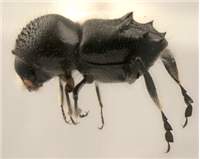Diagnosis
Unmistakable morphology: large pronotum, elytra with distinct, sometimes very large teeth, the last pair of legs very large and flat. Pronotal base bearing a dense tuft of setae, associated with the mesonotal mycangium. Males with large, shovel-like pronotum, and relatively small abdomen.
Distribution
Africa through Oceania, tropical.
Biology
Mostly colonizing small twigs and branches. Short tunnels randomly branching, or radial in twigs.
Taxonomy
Related to Anisandrus and Hadrodemius. Historically often treated as its own tribe. One of the first described xyleborine genera, described by Motschulsky in 1863.
Detailed description
Eyes shallowly emarginate, upper part smaller than lower part. Antennal club approximately circular, club type one (truncated, segment 1 covering posterior side). Segment 1 of club dominant, covering entire posterior face, its margin clearly costate, encircling most or all of frontal club face. Segment 2 narrow, mostly pubescent, visible on anterior side only. Segment 3 absent from posterior side of club. Segment 1 of antennal funicle shorter than pedicel, funicle 4-segmented, scapus appears long and slender. Frons above epistoma mostly smooth, alutaceous, with minor punctures. Submentum slightly impressed, or deeply impressed, shaped as very narrow triangle. Anterior edge of pronotum with two distinct flat serrations protruding anteriad. Pronotum from lateral view rounded and robust (type 5), from dorsal view rounded (type 1), in one rare species type 2, short, parallel-sided, rounded frontally. Pronotal disc shining or smoothly alutaceous, with small punctures, often with dense setae. Lateral edge of pronotum obliquely costate. Procoxae contiguous, prosternal posterocoxal process short and conical, or flat and inconspicuous. Tuft on pronotal basis associated with mesonotal mycangium often very conspicuous. No setae on elytral bases, no elytral mycangium. Scutellum miniature but visible. Elytral bases straight, with oblique edge. Elytral disc short compared to declivity, convex, punctures on elytral disc confused. Elytral declivital impression extending beyond middle of elytra, often nearly to base. Lateral profile of elytral declivity slowly descending, usually excavated, dorsal profile of elytral apex rounded, or elongated and attenuated. Elytral declivity with variable vestiture, ranging from not conspicuously pubescent to covered with dense adherent flat scales. Posterolateral declivital costa absent, or oblique and short. Declivity surrounded by denticles, sometimes conspicuously large ones. Protibiae obliquely triangular, broadest at 2/3 of length. Posterior side of protibia flat, with setal pocket for insertion of tarsi. Protibial denticles large, distinctly longer than wide, but their bases not enlarged, protibial margin mostly rounded; usually between 6 and 8 protibial denticles present. Hind legs greatly extended and broadened (an autapomorphy of the genus), without denticles. Color always dark, from uniformly dark brown to black, only femora often conspicuously white or yellow. Length extremely variable, 1.9 to 4.7 mm.

